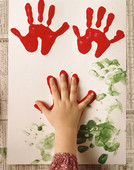
FRIDAY, July 1 (HealthDay News) — Preschool children need to be able to go beyond the number 3 to grasp the true concept of counting, according to researchers.
“We think that seeing that there are three objects doesn’t have to involve counting. It’s only when children go beyond three that counting is necessary to determine how many objects there are,” lead author Elizabeth Gunderson, a graduate student in psychology at the University of Chicago, said in a university news release.
In other words, knowing how to recite “one, two, three” and so on, isn’t the same as grasping that those numbers are connected to actual numerical values.
The study looked at young children’s understanding of the cardinal principle, which states that the size of a set of objects is determined by the last number reached when counting the set.
The study included 44 children and their parents whose interactions were videotaped in 90-minute sessions every four months when the children were ages 14 months to 30 months. When the children were 4 years old, their understanding of the cardinal principle was assessed by the researchers.
Children most likely to understand the cardinal principle were those whose parents talked to them about sets of four to 10 objects that the child could see. When parents used smaller numbers in conversation or referred to objects that children couldn’t see (such as saying “I’ll be there in two minutes”), the children were less likely to understand the cardinal principle.
“The results have important policy implications, showing that specific aspects of parents’ engagement in numerically relevant behaviors in the home seem to have an impact on children’s early mathematical development,” the researchers wrote.
The study appears in the current issue of the journal Developmental Science.
More information
The province of Ontario outlines how parents can help their children learn math.

